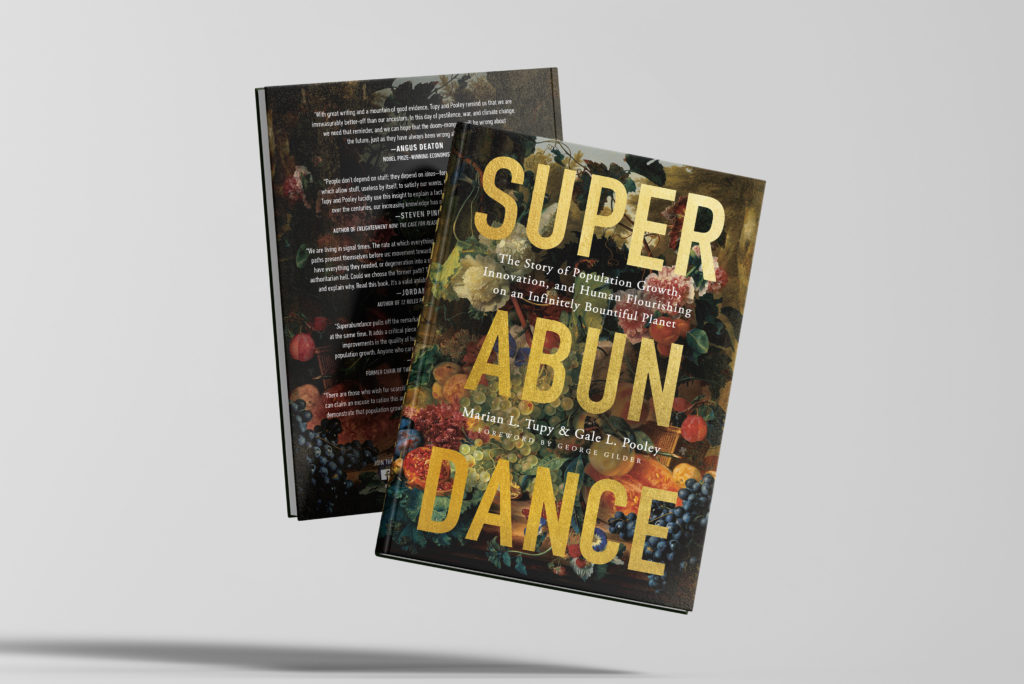“For centuries, the ivory towers of academia have echoed this sentiment of multitudinous ends and limited means. In this supremely contrarian book, Tupy and Pooley overturn the tables in the temple of conventional thinking. They deploy rigorous and original data and analysis to proclaim a gospel of abundance. Economics―and ultimately, politics―will be enduringly transformed.”
―George Gilder, author of Wealth and Poverty, Knowledge and Power: The Information Theory of Capitalism and How it is Revolutionizing our World, and Life After Google: The Fall of Big Data and the Rise of the Blockchain Economy
ORDER HERE
ABOUT SUPERABUNDANCE
Generations of people have been taught that population growth makes resources scarcer. In 2021, for example, one widely publicized report argued, “The world’s rapidly growing population is consuming the planet’s natural resources at an alarming rate . . . the world currently needs 1.6 Earths to satisfy the demand for natural resources . . . [a figure that] could rise to 2 planets by 2030.” But is that true?
After analyzing the prices of hundreds of commodities, goods, and services spanning two centuries, Marian Tupy and Gale Pooley found that resources became more abundant as the population grew. That was especially true when they looked at “time prices,” which represent the length of time that people must work to buy something.
To their surprise, the authors also found that resource abundance increased faster than the population―a relationship that they call “superabundance.” On average, every additional human being created more value than he or she consumed. This relationship between population growth and abundance is deeply counterintuitive, yet it is true.
Why? More people produce more ideas, which lead to more inventions. People then test those inventions in the marketplace to separate the useful from the useless. At the end of that process of discovery, people are left with innovations that overcome shortages, spur economic growth, and raise standards of living.
But large populations are not enough to sustain superabundance―just think of the poverty in China and India before their respective economic reforms. To innovate, people must be allowed to think, speak, publish, associate, and disagree. They must be allowed to save, invest, trade, and profit. In a word, they must be free.
BOOK SUMMARY
In the first part of this book, the human propensity toward the negative is contrasted with the generally improving state of the world. Instead of the apocalypse that humanity has been expecting since the dawn of time, the world has seen great progress. One of the persistent sources of concern about the present state of the world and the future of humanity is population growth. Some people fear this might lead to the exhaustion of resources, thus ending in a calamity for the planet and the species that inhabit it. But there are many reasons why that need not be the case. Continue reading →
READ THE INTRODUCTION
Start with a brain teaser. It is 1980, and you are getting married. Your parents invite 100 guests to the wedding reception. The reception costs them $100 per person, or $10,000 in total. Fast-forward to 2018. Now it is your turn to throw a wedding reception for your child. The guest list has increased by 72 percent. Some of the old folks are no longer around, but the cousins have grown in number. That means that you are now catering for 172 people. If the price per guest had remained the same, your bill would amount to $17,200. Instead, the bill comes to $4,816, which is less than half of what your parents paid for you. You ask the caterer: How is this possible? The caterer responds that for every 1 percent increase in attendance, the bill fell by 1 percent. While the number of guests rose by 72 percent, then, your bill has declined by 72 percent.
Surely, things like that don’t happen in real life. Continue reading →


